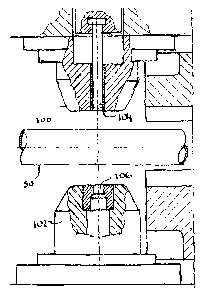Une partie des informations de ce site Web a été fournie par des sources externes. Le gouvernement du Canada n'assume aucune responsabilité concernant la précision, l'actualité ou la fiabilité des informations fournies par les sources externes. Les utilisateurs qui désirent employer cette information devraient consulter directement la source des informations. Le contenu fourni par les sources externes n'est pas assujetti aux exigences sur les langues officielles, la protection des renseignements personnels et l'accessibilité.
L'apparition de différences dans le texte et l'image des Revendications et de l'Abrégé dépend du moment auquel le document est publié. Les textes des Revendications et de l'Abrégé sont affichés :
| (12) Demande de brevet: | (11) CA 2370811 |
|---|---|
| (54) Titre français: | STRUCTURE DE CHASSIS DE SIEGE ET METHODE DE FORMAGE |
| (54) Titre anglais: | SEAT FRAME STRUCTURE AND METHOD FOR FORMING |
| Statut: | Réputée abandonnée et au-delà du délai pour le rétablissement - en attente de la réponse à l’avis de communication rejetée |
| (51) Classification internationale des brevets (CIB): |
|
|---|---|
| (72) Inventeurs : |
|
| (73) Titulaires : |
|
| (71) Demandeurs : |
|
| (74) Agent: | GOWLING WLG (CANADA) LLP |
| (74) Co-agent: | |
| (45) Délivré: | |
| (22) Date de dépôt: | 2002-02-06 |
| (41) Mise à la disponibilité du public: | 2003-08-06 |
| Licence disponible: | S.O. |
| Cédé au domaine public: | S.O. |
| (25) Langue des documents déposés: | Anglais |
| Traité de coopération en matière de brevets (PCT): | Non |
|---|
| (30) Données de priorité de la demande: | S.O. |
|---|
The present invention provides a method of forming a transversely
extending passage through a tubular seat frame for receiving a headrest guide
tube
and includes the steps of:
(i) forming first and second diametrically opposed axially aligned
openings through the tubing;
(ii) flowing metal from around the first opening through the tube and
through the second opening while expanding the first opening to form at
least part of an inner wall of the passage;
(iii) flowing metal from around the second opening outwardly from the
tube while expanding the second opening to form an outer wall of the
passage extending about the inner wall.
Note : Les revendications sont présentées dans la langue officielle dans laquelle elles ont été soumises.
Note : Les descriptions sont présentées dans la langue officielle dans laquelle elles ont été soumises.

2024-08-01 : Dans le cadre de la transition vers les Brevets de nouvelle génération (BNG), la base de données sur les brevets canadiens (BDBC) contient désormais un Historique d'événement plus détaillé, qui reproduit le Journal des événements de notre nouvelle solution interne.
Veuillez noter que les événements débutant par « Inactive : » se réfèrent à des événements qui ne sont plus utilisés dans notre nouvelle solution interne.
Pour une meilleure compréhension de l'état de la demande ou brevet qui figure sur cette page, la rubrique Mise en garde , et les descriptions de Brevet , Historique d'événement , Taxes périodiques et Historique des paiements devraient être consultées.
| Description | Date |
|---|---|
| Inactive : CIB de MCD | 2006-03-12 |
| Inactive : CIB de MCD | 2006-03-12 |
| Inactive : CIB de MCD | 2006-03-12 |
| Inactive : CIB de MCD | 2006-03-12 |
| Le délai pour l'annulation est expiré | 2006-02-06 |
| Demande non rétablie avant l'échéance | 2006-02-06 |
| Réputée abandonnée - omission de répondre à un avis sur les taxes pour le maintien en état | 2005-02-07 |
| Lettre envoyée | 2003-11-21 |
| Inactive : Transfert individuel | 2003-09-25 |
| Demande publiée (accessible au public) | 2003-08-06 |
| Inactive : Page couverture publiée | 2003-08-05 |
| Lettre envoyée | 2002-04-26 |
| Inactive : CIB attribuée | 2002-04-17 |
| Inactive : CIB en 1re position | 2002-04-17 |
| Inactive : CIB attribuée | 2002-04-17 |
| Inactive : Lettre de courtoisie - Preuve | 2002-03-12 |
| Demande reçue - nationale ordinaire | 2002-03-06 |
| Exigences de dépôt - jugé conforme | 2002-03-06 |
| Inactive : Certificat de dépôt - Sans RE (Anglais) | 2002-03-06 |
| Inactive : Transfert individuel | 2002-03-04 |
| Date d'abandonnement | Raison | Date de rétablissement |
|---|---|---|
| 2005-02-07 |
Le dernier paiement a été reçu le 2004-02-05
Avis : Si le paiement en totalité n'a pas été reçu au plus tard à la date indiquée, une taxe supplémentaire peut être imposée, soit une des taxes suivantes :
Veuillez vous référer à la page web des taxes sur les brevets de l'OPIC pour voir tous les montants actuels des taxes.
| Type de taxes | Anniversaire | Échéance | Date payée |
|---|---|---|---|
| Taxe pour le dépôt - générale | 2002-02-06 | ||
| Enregistrement d'un document | 2002-03-04 | ||
| Enregistrement d'un document | 2003-09-25 | ||
| TM (demande, 2e anniv.) - générale | 02 | 2004-02-06 | 2004-02-05 |
Les titulaires actuels et antérieures au dossier sont affichés en ordre alphabétique.
| Titulaires actuels au dossier |
|---|
| TRITON TUBULAR COMPONENTS CORP. |
| Titulaires antérieures au dossier |
|---|
| BILL FRENKE |
| JOHN MCWHINNIE |